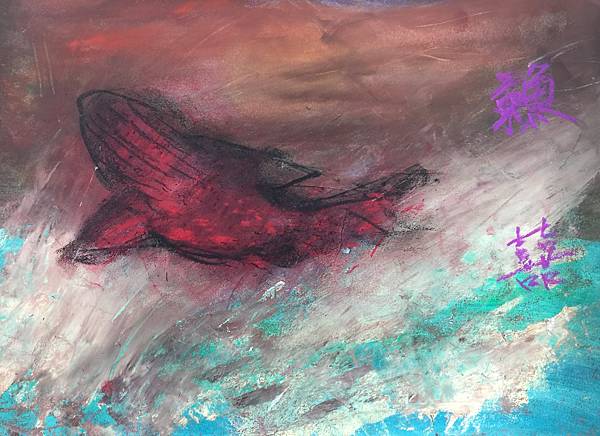在這裡沒有一位聞名世界的文森.梵谷,
而是上百位在日間型精神復健機構(社區復健中心),經歷美好創作時光的我們。
初秋的台北,社區精神復健中心的學員帶著作品北上,親自佈置了屬於他們的畫展~文森.梵谷不在這。
身為陪伴精神康復者創作的藝術治療師我,希望透過這次展覽與市民朋友一起來思考,藝術活動如何能幫助精神康復者∶抒發情緒-表達想法-建立關係,甚至進一步融入社會〭
此展覽以藝術治療概念規劃三個展覽主題和一個工具展區,闡述高雄市立凱旋醫院附設社區復健中心如何建構一個安全、被尊重、被接納與支持的環境,來鼓勵學員融入社區參與藝術創作。
透過安排我們將現場畫作區分成四個主題區,以呈現凱旋醫院精神復健藝術治療團體致力營造的支持性環境∶
一、尊重個人自主與隱私∶學員對作品意涵擁有絕對的詮釋權,也包含拒絕詮釋的權力。
二、發展個人美感與特質∶學員可以定義屬於自己的美感,選擇自己偏好的媒材和主題。
三、接納現狀與關係的重塑∶提供學員一個開放而接納的環境,重新模塑正向的人際關係。
四、藝術治療道具展區∶小小道具能幫助沒有美術基礎的學員們體驗創作的美好。
此外,台灣每隔一段時間有關精神康復者該積極融入社區或是隔離照護的議題就會被重新檢視,然而我們的社區文化是否能承接住精神康復者?允許更多的接納?
我們相信只有身處包容和善意的家庭、校園與社會,人們的身心方得以處於安適的狀態social well-being。在這些正向的因子不斷地被剝奪與削弱的現代社會體制中,我們也希望每一位關心精神健康的市民都能思考,是否只有精神康復者需要上述所提及的支持性環境?或許在為精神康復者建造更友善的環境同時,我們同時也為自己打造一個更安適的社區。
我們期待這個展覽不只是跟大眾分享學員們的創作,更盼望藉此展覽喚起每一位民眾對營造「精神心理友善家園」的意識。
策展人:藝術治療師許乃文 diana0809@usa.net
1948年世衛World Health Organization, WHO對健康的定義提到健康是一個國家人民擁有完整身體、心理及社會的安適狀態(state of complete physical, mental and social well-being),不僅是指沒有疾病或虛弱的身體現象而已。
Vincent Van Gogh is not here.
You can’t find the world-renowned Vincent Van Gogh here, but rather, you can find hundreds of us stand here united in the Day Psychiatric Rehabilitation Institution (community rehabilitation center) to experience wonderfully creative moments.
Through this exhibition, we want to engage in dialogue with citizens and friends, collectively pondering how art activities can assist in psychiatric rehabilitation: expressing emotions, conveying ideas, establishing relationships, and even further helping integrating into society. This exhibition, based on the concept of art therapy, plans three exhibition themes and a tool exhibition area, elucidating how the Kaohsiung Municipal Kai-Syuan Hospital-Affiliated Community Rehabilitation Center constructs a safe, respected, accepted, and supportive environment to encourage participants to integrate into the community through artistic creation. In the artworks on display, you can find artworks and explanations corresponding to the following themes:
Respect for individuality and privacy: Participants have absolute interpretive rights to introduce their works, also have the right to refuse interpretation.
Development of personal aesthetics and characteristics: Participants can define their own sense of beauty, choose their preferred materials and themes.
Acceptance of the current situation and reshaping of relationships: Providing participants with an open and welcoming environment to rebuild positive interpersonal relationships.
Art therapy tool exhibition area: Small tools can help participants without artistic background experience the beauty of creation.
In Taiwan, the issues related to the care of patients with mental illness are periodically re-examined. However, is it only patients with mental illness who need such supportive environments? We believe that in order to achieve physical and mental well-being, we need to provide inclusive and benevolent families, campuses, and societies. In a modern society where these positive factors are constantly being deprived and weakened, we hope this exhibition will not only share the beautiful creations of our participants but also awaken citizens’ awareness of creating a "psychologically friendly home."
Curator: Hsu Nai-Wen.
In 1948, the World Health Organization (WHO) defined health as a state of complete physical, mental, and social well-being and not merely the absence of disease or infirmity.

















